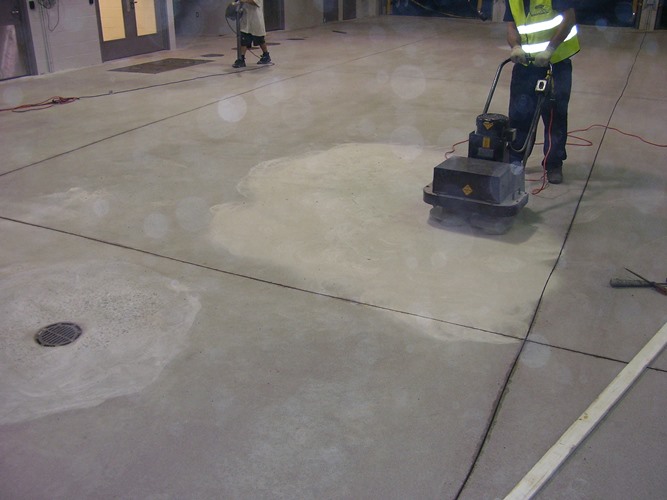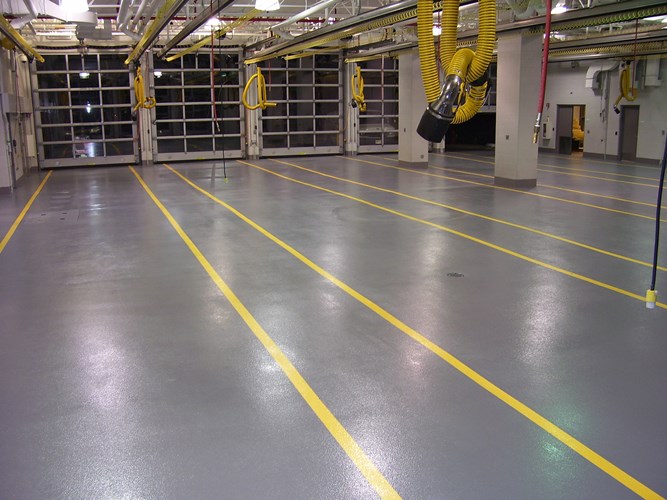It’s not often that a fire station sounds the alarm, but when the Perth Amboy Fire Department realized how poorly their builder had poured the concrete floor in their new station, they immediately called in the big guns. Because of the large geographic area this station serviced, the city needed a company that had experience installing safe, durable flooring systems for emergency vehicles.
Enter Criterion Flooring. Based in Elkridge, Md., Criterion started in 1972, and it has been in the niche market of fire station floor coatings since 2000 when Jim Peterson and his partner bought the company. They have done hundreds of fire station floors in New Jersey alone.
“We’ve been doing this for quite some time,” said Peterson. “When we started in this market, very few people in the whole of the northeast were serving fire stations. And today, although more competitors have joined the field, Criterion may not be the biggest or the cheapest, but we are the company a city calls when they need the job done right.”
The team had some hurdles to face, including lighting and power issues. They didn’t have proper light or power setup — breakers kept tripping — so the Criterion crew had to stop work and bring in a generator.
Adding to the pressure, the city had scheduled a Grand Opening event for the new Public Safety Complex, which included the fire station, as well as other emergency service providers, a court house, and a community center. The ceremony was right around the corner, so the pressure was on.
Leveling the Playing Field
“Our crew did what they always do — they jumped out of the truck ready to go,” said Peterson.
The team had their fair share of work ahead of them. The floor’s concrete was unlevel; water was pooling in the middle of the floor creating “birdbaths” everywhere. Many of the drains were not functional because the concrete was too high and the water had no way of flowing into them. In other areas, the floor would either slope away from the drain or right into an entry door.
“It’s not like we haven’t seen these types of problems before,” explained Peterson. “But the builder tried to hide the fact that the concrete was defective. So, at the last minute, we had to redo a lot of the work — grind down the concrete near the drains and then build it back up — on top of resurfacing the floor.”

The floors at a fire station are critical. They must be level so they are not a trip hazard for a fireman, running to his truck. And they need to be a little rough; an overly smooth surface could also cause a fall. Finally, they must have a perfect finish to prevent stains from brake and hydraulic fluid as well as black “paw prints,” when the hot tire leaves a mark.
Fortunately, Peterson invented a tool to determine the pitch of a floor that saves a lot of time and aggravation.
“Normally, you can only tell the pitch of floor by flooding it with water,” explained Peterson. “We did do that initially, but as we begin to grind and coat the surface, we can’t introduce water because epoxy and water don’t mix. So, once the coating is down, we [used] steel chrome balls to roll across the floor to identify where and how the floor is pitched as water would.”
The team used hand grinders and Equipment Development Co., Inc. (EDCO) grinders to level and change the pitch. Next, they filled all of the low areas with a silica and epoxy slurry.
A Precise Process
Once Criterion had created a level plane surface, they started their five-layer process: primer, basecoat, broadcast (which used sand), seal coat, and topcoat. This progression is needed to effectively resurface and coat the floor.
The team primed the entire area with Wear Coat 1020 water-borne primer. They applied a basecoat of Wear Coat 440 Epoxy and broadcasted silica sand into it.
Criterion likes to do a double broadcast using quartz, which is more spherical (imagine a round bead versus fine, powdery sand.) “This gives a great foundation for the system, which you need for these heavy and huge trucks,” explained Peterson. “The tires are piping hot when the truck comes in from off the street. If the floor is not coated properly, the coating comes right back off on the tires. Using quartz helps the system have more impact resistance and integrity.”
Once that cured, the team removed the excess sand and applied a grout coat, or seal coat, made up of silica and Wear Coat 440 Epoxy.
The final step was to top-coat the floor with Wear Coat 100 Urethane, which they also used to add lines and a custom logo on the last day.
“The Wear Coat 100 topcoat urethane is the only topcoat that has proven to be able to hold up in these abusive environments,” said Peterson. “It holds up against Skydrol, a very harsh hydraulic fluid found in many fire trucks and doesn’t leave paw prints from the tires. It goes down at 6 mils [152.4 microns] as opposed to the 3 mils [76.2 microns] that you get from the other topcoats.”
The crew wore safety vests, boots, eye protection, and dust masks as well as respirators when applying the coatings.
All’s Well That Ends Well
The five-step process normally takes a full seven days, but the team completed it in four and half by working around the clock. If the primer was dry at 2:00 a.m., the team was back at work then, too.
Thanks to a hard-working and knowledgeable crew, the team completed the project in time for the Grand Opening ceremony.
Peterson gives a lot of credit to Jose Rodriquez, his foreman. “Jose has been doing this for 30 years,” he said. “He has a ton of experience and will go on site and take charge of the project. He gets it done right. He knows the formulas for success as he mixes the various coats — he knows the secret sauces.”
“All our crew is experienced and hard-working,” Peterson added. “And that is paramount.”
